4
Neolithic Period
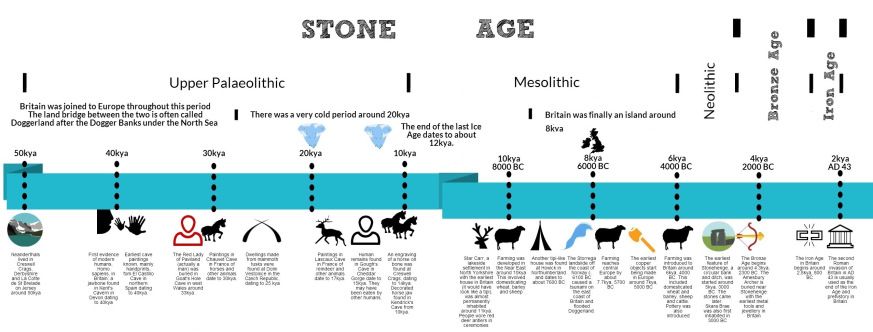
By 8000 BCE, possibly the most important transformation in the history of human civilization took place: around the world, the in the Near East, in South and Central America, and in Southeast Asia, human beings ceased to hunt and began instead to farm, plowing and planting seeds, growing crops, and domesticating animals, using them not only as a reliable source of food and clothing, but also beasts of burden, inaugurating what is known as the Neolithic period (“New Stone Age”). Hunters and gatherers became herders and farmers, and more permanent societies began to develop.
This transformation from a nomadic life to a more settled one revolutionized life for prehistoric people. One historian categorized the Neolithic era as the matrix from which civilization appears and provides the preconditions on which it rests. These preconditions include the ability to grow wheat, maize, rice, and barley, along with the capability of domesticating formerly wild pigs, goats, sheep, and cattle. These developments radically altered the conditions of human existence.
The Agricultural Revolution
As the ice covering the Northern Hemisphere began to recede around 10,000 BCE, the seas rose, covering, for instance, the cave entrance at Cosquer in southern France, filling what is now the North Sea and English Channel with water, and inundating the land bridge that had connected Asia and North America. Agriculture began to replace hunting and gathering, and with it, a nomadic lifestyle gave way to a more sedentary way of life. The consequences of this shift were enormous, and it ushered in the Neolithic era.
For 2,000 years, from 10,000-8,000 BCE, the ice covering the Northern Hemisphere receded farther and farther inward. As temperatures warmed, life gradually changed. During this period of transition, areas once covered by vast regions of ice and snow developed into grassy plains and abundant forests. Hunters developed the bow and arrow, which were easier to use at longer range on the open plains. They fashioned dugout boats out of logs to facilitate fishing, which became a major food source. They domesticated dogs to help with the hunt as early as 11,000 BCE, and soon other animals as well – goats and cattle particularly. Perhaps most important, people began to cultivate the more edible grasses. Along the easter shore of the Mediterranean, they harvested wheat; in Asia, they cultivated millet and rice; and in the Americas, they grew squash, beans, and corn. Gradually, farming replaced hunting as the primary means of sustaining life. A culture of the fields developed – an agriculture.
Agricultural production seems to have originated about 10,000 BCE in the Fertile Crescent, an area arching from southwest Iran, across the foothills of the Taurus Mountains in southeastern Turkey, then southward into Lebanon. By about 8,000 BCE, Neolithic agricultural societies began to concentrate in the great river valleys of the Middle East and Asia. Here, distinct centers of people involved in a common pursuit began to form. A civilization is a social, economic, and political entity distinguished by the ability to express itself through images and written language. Civilizations develop when the environment of a region can support a large and productive population. An increasing population requires increased production of food and other goods, not only to support itself, but to trade for other commodities. Organizing this level of trade and production also requires an administrative elite to form and to establish priorities. The existence of such an elite is another characteristic of civilization. Finally, as the history of cultures around the world makes abundantly clear, one of the major ways that societies have acquired the goods they want and simultaneously organized themselves is by means of war.
Gradually, as the climate warmed, Neolithic cultures spread across Europe. By about 5000 BCE, the valleys of Spain and southern France supported agriculture, but there is no evidence of farming in the northern reaches of the European continent and England dating back any earlier than about 4000 BCE. The Neolithic era did not end in these colder climates until about 2000 BCE, and continued in more remote regions, such as Africa and the Americas, well into the first millennium.
Meanwhile, the great rivers of the Middle East and Asia provided a consistent and predictable source of water, and people soon developed irrigation techniques that fostered organized agriculture and animal husbandry. As production outgrew necessity, members of the community were free to occupy themselves in other endeavors – complex food preparation (cheese, bread, beer, etc.), construction, religion, and military affairs. Soon, permanent villages began to appear, and villages began to look more and more like cities.
Mesopotamia: The Cradle of Civilization
Even before Stonehenge was built in England, two are more advanced civilizations were developing in the Near East: that of Mesopotamia and that of Egypt. Mesopotamian civilization developed in the valley between the Tigris and Euphrates Rivers: Mesopotamia is a Greek word that literally means “the land between two rivers.” Consisting of the eastern part of what is known as the Fertile Crescent, which extends northward along the eastern coast of the Mediterranean through what is today Israel and Lebanon, eastward into present-day Syria and Iraq, and south the Tigris and Euphrates valleys to the Persian Gulf, Mesopotamia was the most fertile and arable land in the Near East, and perhaps, at the dawn of the Neolithic Age, the most fertile in the world. It was here, at any rate, that around 9000 BCE agriculture was first fully developed.
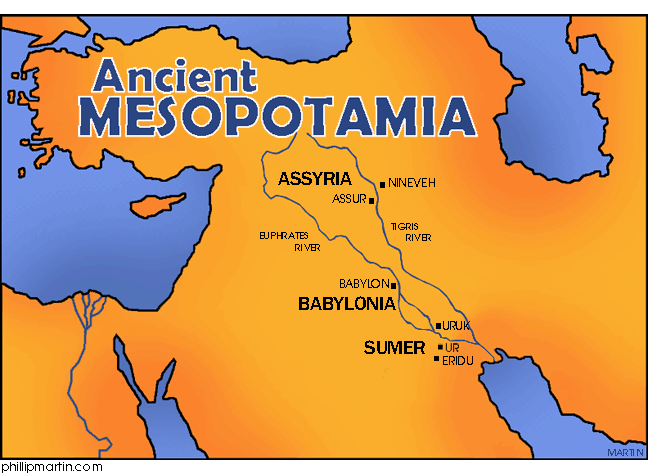
The peoples of Mesopotamia were almost totally dependent on the Tigris and Euphrates Rivers for their livelihoods. By irrigating the lands just outside the marshes on the riverbanks, the conditions necessary for extensive and elaborate communities such as Ur began to arise: people dug canals and ditches and cooperated in regulating the flow of water in them, which eventually resulted in crops that exceeded the needs of the population. These could be transformed into foodstuffs of a more elaborate kind, including beer. Evidence indicates that over half of each grain harvest went into producing beer. Excess crops were traded by boat with nearby communities or up the great rivers to the north, where stone, wood, and metals were available in exchange. As people congregated in central locations to exchange goods, cities began to form. Cities such as Ur became hubs of great trading networks. With trade came ideas, which were incorporated into local custom and spawned newer and greater ideas in turn. Out of the exchange of goods and ideas, then, the conditions were in place for great cultures to arise.
By about 3000 BCE, two further developments had taken place that had a decisive influence on the course of civilization. Sometime after 6000 BCE, people learned to mine and use copper; by 3000 BCE, they had discovered that by combining tin with copper, they could produce a much stronger alloy, bronze, which allowed tremendous innovations in the production of weapons, tools, and jewelry. This marked the beginning of the Bronze Age.
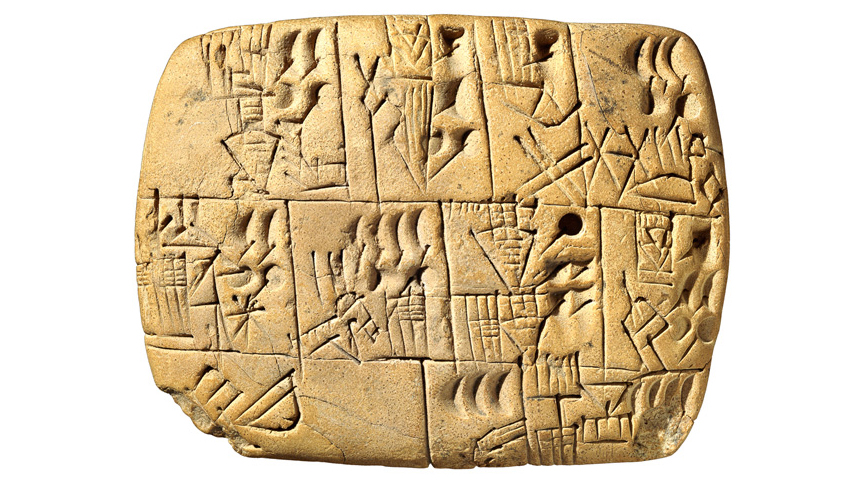
The second development marks the move from prehistory into the first historical period – that is, a period for which written records exist. By about 3000 BCE, the people of ancient Mesopotamia were using written language, known today largely from the clay tablets that were first unearthed in the mid-19th century. Chiefly the province of the upper class and priests, this writing was accomplished in wedge-shaped cuneiform characters made with a stylus that was itself wedge-shaped and that waws pressed into wet clay tablets. The original purpose of this writing se4ems to have been to keep agricultural records. Among the oldest examples of cuneiform writing, for instance, is a tablet from a temple complex at Uruk that lists sacks of grains and heads of cattle. Cuneiform writing began as a pictographic system. In its earliest form, the symbol for “cow” and was an abstract picture of a cow’s head. But the pictographs were quickly abstracted even further, presumably in no small part because it was difficult to draw a curve with a reed stylus in wet clay. Between 2500-1800 BCE, the sign for “cow” was first turned 90 degrees sideways and converted in a series of quickly imprinted wedges.
By combining pictograms, more complex ideas – or ideograms – and even abstract ideas could be represented. A bird next to an egg meant “fertility.” Two crossed lines meant “hatred” or “enmity.” Parallel lines signified “friendship.”
Sometime around 2000 BCE, another important development occurred, when pictograms began to represent not only objects but sounds – the birth of phonetic writing. Assisted by these technical advances, the successive civilizations of Sumer, Akkad, and Babylon blossomed in Mesopotamia over the following 1,500 years.
Sumer: The First Civilization
The Sumerians, who lived at the southern end of the Tigris and Euphrates Rivers, founded the Mesopotamian civilization between 3500-3000 BCE, contemporary with the beginning of Egyptian civilization. Sumerian culture reached its zenith approximately 2800-2700 BCE. It was at this time that Sumer’s most famous king, Gilgamesh, ruled Uruk, one of the many independent city-states in Mesopotamia.
Each Sumerian city-state had its own local goad and its own local ruler. The kings were not thought of as gods – rather, the god was considered the owner of the city-state, with the king as an intermediary between the god and the people. In each city, the buildings were clustered around the temple of the city’s god. Religion focused on seasonal fertility. Agricultural mythology included the Bull of Heaven, whose fiery breath could burn crops, and Imdugud, a lion-headed eagle whose wings covered the heavens in dark clouds, a good creature who brought rain and ended droughts brought on by the Bull of Heaven.
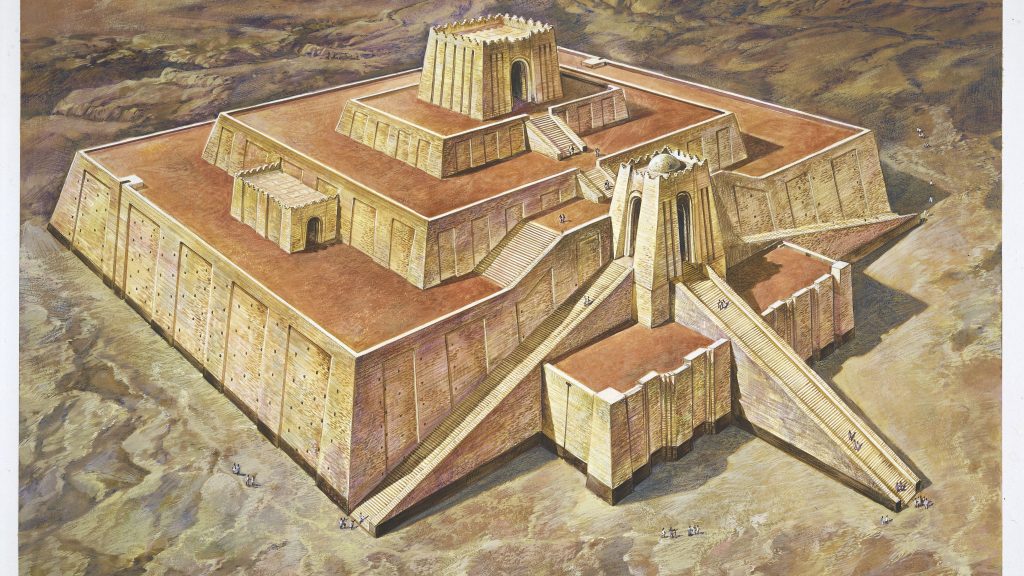
Like most early religions, Sumerian and Mesopotamian religions were polytheistic – that is, there were many gods and goddesses, who often competed with one another for the attention of worshippers. The gods were human in form, and they possessed human personalities and foibles – that is, they were anthropomorphic. The cuneiform sign for god is a star, which also means “on high,” or “elevated” as well as “in the heavens.”
Sumerian: The First Written Language
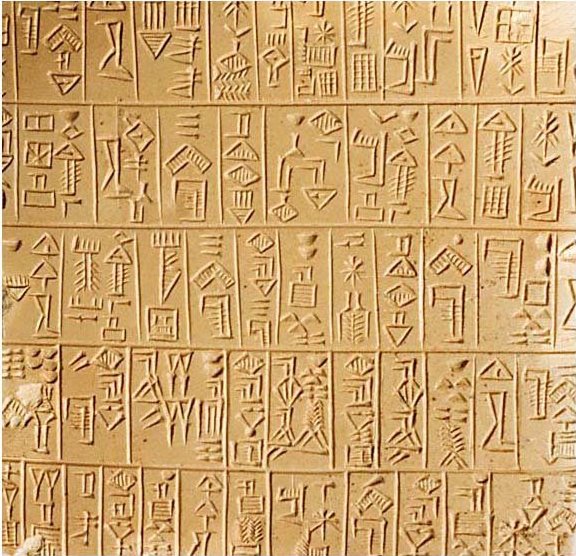
Without writing, there would have been no permanent recording, no history, and, of course, no books. How did it begin? The favored explanation, until the Enlightenment in the 18th century, was divine origin. Today many – if not most – scholars accept that the earliest writing evolved from accountancy. Inventories and calculations are certainly crucial in the written records of ancient Mesopotamia and Crete, although they are puzzlingly little to be seen in the surviving records of ancient Egypt, India, China, and Meso-America. In other words, sometime in the late 4th millennium BCE, in the cities of Sumer in Mesopotamia (the “cradle of civilization”), the complexity of trade and administration reached a point where it outstripped the power of memory among the governing elite. To record transactions in an indisputable, permanent form became essential.
Some scholars believe that a conscious search for a solution to this problem by an unknown Sumerian individual in the city of Uruk (biblical Erech) around 3300 BCE produced writing. Others posit that writing was the work of a group, presumably of clever administrators and merchants. Still others think it was not an invention at all, but an accidental discovery. Many regard it as the result of evolution over a long period, rather than a flash of inspiration. One particularly well-aired theory holds that writing grew out of a long-standing counting system of clay tokens. Such tokens – varying from simple, clay discs to more complex, incised shapes whose exact purpose is unknown – have been found in many Middle Eastern archeological sites dated 8000-1500 BCE. The substitution of two-dimensional symbols in clay for these three-dimensional tokens was the first step toward writing, according to this theory. One major difficulty is that the tokens continued to exist long after the emergence of Sumerian cuneiform writing for almost two millennia; another is that a two-dimensional symbol on a clay tablet might be thought to be a less, not a more, advanced concept than a three-dimensional token. It seems probable that the tokens accompanied the emergence of writing, like tallies, rather than giving rise to writing.
To express the range of human thought requires a writing system intimately linked with spoken language. The symbols of what may have become the first fully developed writing system are generally thought to have been pictograms: iconic drawings of, say, a pot or a fish or a woman. These have been found in Mesopotamia and Egypt dating to the fourth millennium BCE, in the Indus Valley of India/Pakistan dating to the third millennium, and in China dating to as early as the fifth millennium. In many cases, their iconicity soon became so abstract that it is barely perceptible to us.
Yet pictograms were insufficient to express the kinds of words, and the constituent parts, that cannot be depicted. Essential to the development of full writing, as opposed to limited, purely pictographic “proto-writing,” was the discovery of the “rebus principle.” This radical idea enables phonetic values to be represented with pictographic symbols. Thus in English, a picture of a bee beside the number four might represent the word “before.” In an early Sumerian accounting tablet the abstract word “reimburse” is represented by a picture of a reed, because “reimburse” and “reed” shared the same phonetic value in the Sumerian language. Egyptian hieroglyphs are also full of rebuses. For example, the sun sign, pronounced “Ra,” is the first symbol in the hieroglyphic spelling of the pharaoh’s name Ramesses.
Gilgamesh: The Oldest Story Ever Written
Sumerian literature survives on nearly 100,000 clay tablets and fragments. The oldest known literary work in the world is the Epic of Gilgamesh, the earliest elements of which date from about 1900 BCE, when Gilgamesh reigned in the Euphrates city-state of Uruk. Legends about Gilgamesh were told but not recorded until hundreds of years after his death. Before about 2000 BCE, these stories were recorded on cuneiform tablets. From around 1900-1600 BCE onward, the Gilgamesh stories were written down by the Akkadians, a people who spoke an early Semitic language related to both Hebrew and Arabic. The earliest known version of the epic was discovered in the 7th century BCE in the library of an Assyrian king, Ashurbanipal.
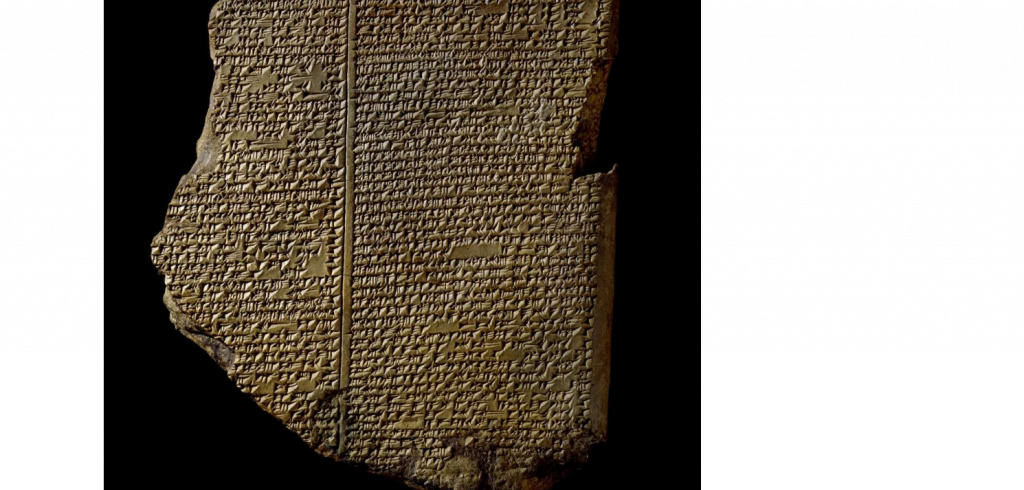
Like other ancient epics such as those of Homer, The Epic of Gilgamesh includes elements of folklore, legend, and myth that accrued over time. The work is compiled of originally separate stories concerning Gilgamesh, Enkidu (a primeval human figure), Utnapishtim (a Babylonian counterpart of Noah), and others.
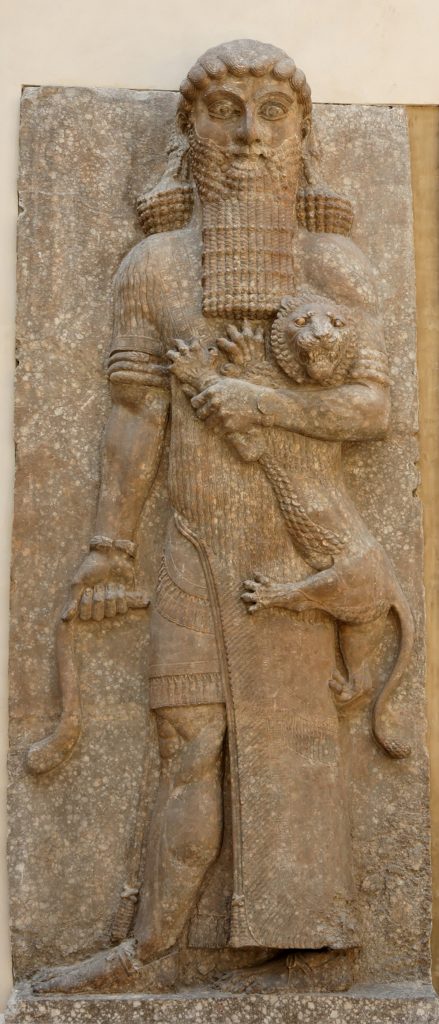
The epic begins with a kind of prologue that emphasizes Gilgamesh’s wisdom as a ruler and his importance to recorded history. The prologue also characterizes him as a semidivine figure, who, though not immortal, is courageous, strong, and beautiful. He is also described as an arrogant and oppressive ruler. When his people cry out for help to their gods for assistance, the god Anu creates Enkidu, a primitive combination of man and wild animal, a figure related to those depicted on the lyre of Queen Puabi in Ur.
The story of the mutually positive influences Gilgamesh and Enkidu exert upon each other, of their developing friendship, and their heroic adventures occupy the bulk of the epic. An additional segment concerning Gilgamesh in the Underworld forms a sort of epilogue. In their first adventure, Gilgamesh and Enkidu confront and kill the giant Humbaba. When the goddess Ishtar proposed that Gilgamesh become her lover, he refuses, which precipitates the goddess sending the Bull of Heaven to destroy the city of Uruk by famine.
The second adventure of Gilgamesh and Enkidu involves the slaying of the destructive Bull, the punishment for which is Enkidu’s death through illness. After losing his companion, Gilgamesh journeys to visit Utnapishtim, the only human ever granted immortality, but fails to learn the secret of everlasting life, though he does return home having gleaned mush else from the wisdom of Utnapishtim. With this knowledge, he rules as a wise king. Gilgamesh’s adventures are occasions for writers to explore questions that will be raised again in later epics. What is the relationship between humans and their gods? How are humans linked with the world of nature? What are the obligations of friendship, family, and duty? How should we live in the face of mortality?
There are strong parallels between Sumerian mythology and the stories of the biblical book of Genesis. For instance, surviving Sumerian texts parallel the story of Noah and flood, including an episode in The Epic of Gilgamesh. A huge flood did indeed inundate Mesopotamia about 2900 BCE.
Enheduanna: The World’s First Poet

The earliest known poet is the poet-priestess Enheduanna, who wrote in the Sumerian language. Daughter of the Akkadian king Sargon, Enheduanna wrote works that in part assisted her father in his attempt to unite Akkadia and Sumeria. Her best-known poems are hymns to Akkadian and Sumerian gods and goddesses, most notably to Inanna, the Sumerian goddess of love.
“The Blessing of Inanna,” a hymn written by Enheduanna around 2300 BCE, recounts the myth of the goddess, depicted as a young girl from Uruk who decides to visit Enki, the god of wisdom. Inanna travels south to Eridu, the chief seaport of Sumer, where Enki lives. Apparently taken with Inanna, Enki offers a series of toasts, each time bestowing upon her one of his special powers, including the highest powers of all.
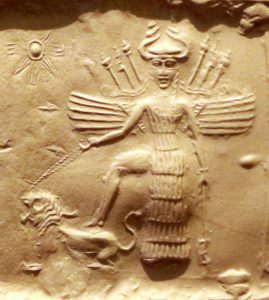
Having gathered all 80 of Enki’s mighty powers, Inanna piles them all into her boat and sails back upriver. The drunken Enki realized what he has done and tries to recover his blessings, but Inanna fends him off. She returns to Uruk, blessed as a god, and enters the city triumphantly, bestowing now her own gifts on her people, who subsequently worship her. Enki and the people of Eridu are forced to acknowledge the glory of Inanna and her city of Uruk, assuring peace and harmony between the two competing city-states.

The Sumerians worshipped Inanna as the goddess of fertility and heaven. In this tale, she and Enki probably represent the spirits of their respective cities and the victory of Uruk over Eridu. That Inanna appears in the work first as a mere mortal is a classic example of anthropomorphism, endowing the gods and forces of nature that they represent with humanlike traits. The story has some basis in fact, since Uruk and Eridu are the two oldest Mesopotamian cities, and surviving literary fragments suggest that the two cities were at war sometime after 3400 BCE.
Ancient Egypt

Like its Mesopotamian counterpart, ancient Egypt civilization developed slowly from about 5000 BCE to approximately 3100 BCE with no united or central government. There were in essence two independent Egypts: Upper Egypt and Lower Egypt. Upper Egypt was a narrow strip of land on either side of the Nile River, extending seven hundred miles from the cataract, or waterfall, in the south to the Nile Delta. Lower Egypt was situated in the northern lands of the fertile Nile Delta where the river branches out and runs in the Mediterranean Sea. Then, around 3100 BCE, the two Egypts were united by the king of Upper Egypt, Narmer, also known as Menes, and it is with this even that Egyptian history is usually said to begin. The even is celebrated in one of the earliest surviving Egyptian stone sculptures, the Palette of Narmer.
Egyptian history is traditionally divided into about thirty dynasties. We know very little about the first two dynasties, but beginning with the third, the Egyptian dynasties are grouped into several major periods distinguished by their stability and achievement: the Old Kingdom (2686-2181 BCE, consisting of dynasties 1-11), the Middle Kingdom (2040-1786 BCE, consisting of dynasties 11-14), and the New Kingdom (1552-1069 BCE, consisting of dynasties 18-20). The so-called “Intermediate” periods of relative instability intervened between each of the kingdoms, and the last New Kingdom was followed by a Late Period that concludes around 525 BCE when Egypt finally lost its independence and was absorbed into the Persian Empire.
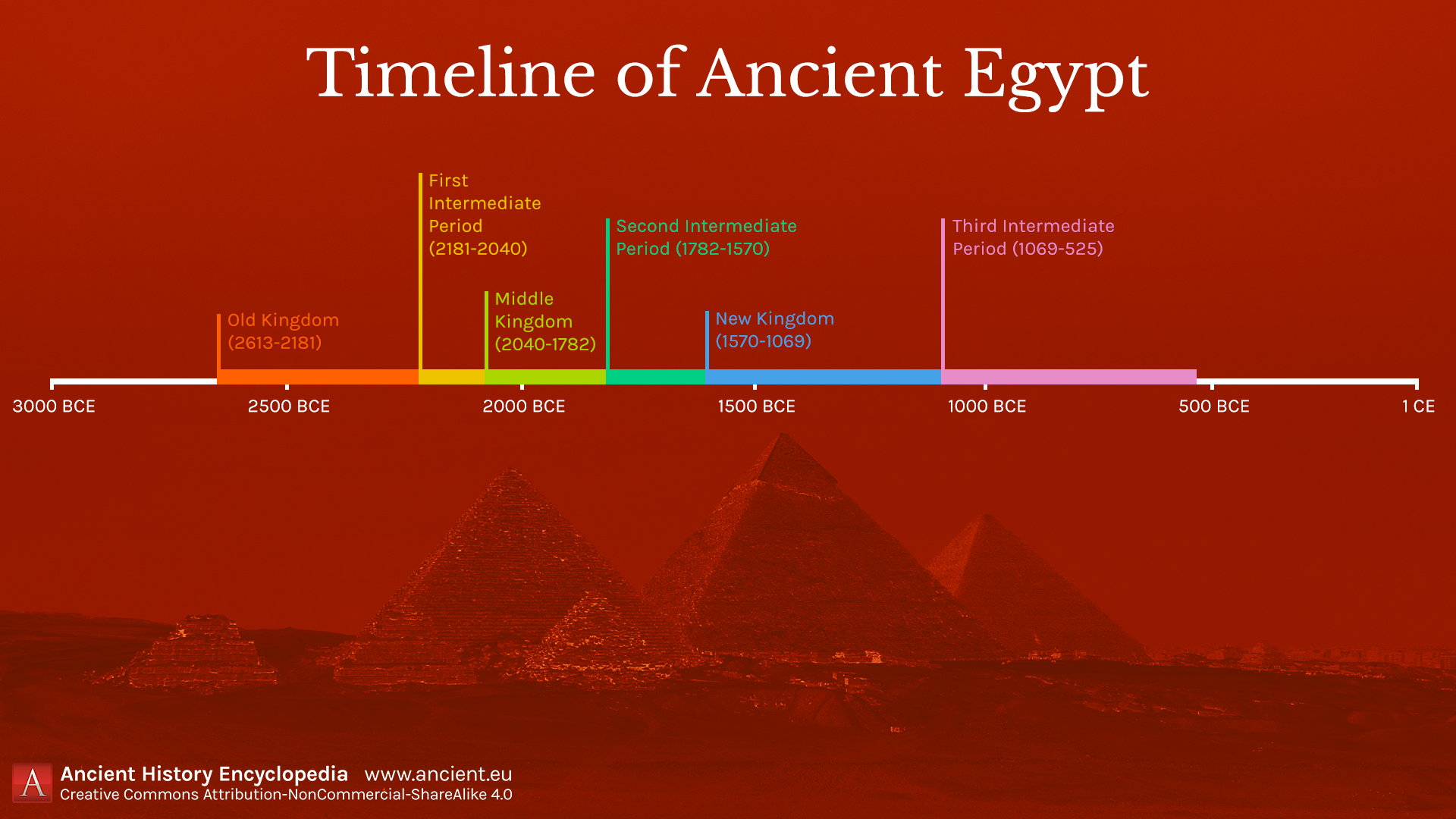
Despite times of relative disruption, life was unusually secure in ancient Egypt. The fertility of the Nile Valley, which was due to the huge amounts of topsoil swept each summer into the Nile River delta from far upstream in the African lake region and the Ethiopian plateau, supported the establishment of a permanent agricultural society. Moreover, the surrounding deserts largely eliminated the fear of invasion. The king, later called pharaoh, which means “great house,” was the absolute ruler and considered divine. Beneath him was a large class of priests and government bureaucrats. The permanence and stability of life and the highly centralized organization of ancient Egyptian society is reflected in the monumental and essentially permanent architecture of the pyramids. In fact, with few exceptions, the art of Egypt remained remarkably consistent in style over three millennia. The unquestioning acceptance of convention is a major characteristic of ancient Egyptian culture. As a result, a sense of order and continuity pervades the history of Egyptian life and art.
Hieroglyphics
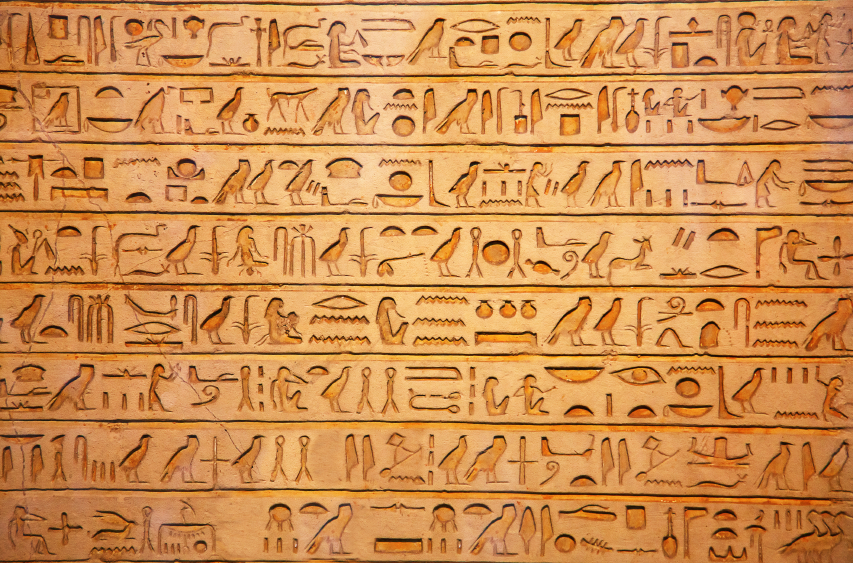
The Egyptians developed a calendar, used irrigation systems, discovered the use of basic metals, and started using hieroglyphics, their writing system, all before 3000 BCE. For centuries, scholars thought that the glyphs or characters used in hieroglyphics all represented complete ideas rather than individual units of sound. Until 1822, the actual meaning of hieroglyphics was unknown. Then a Frenchman named Jean Francois Champollion deciphered the Rosetta Stone. This was a large fragment of basalt that had been found during Napoleon’s military campaign in Egypt near the town of Rosetta in the Nile Delta. When it became apparent that the three languages on the Rosetta Stone expressed almost the same thing – a decree in honor of Ptolemy V (196 BCE) – Champollion was able to establish that the corresponding Egyptian symbols were meant, as in Sumerian, to be read not just symbolically but phonetically as well. Thus, although a pictograph of a fish did indeed represent a fish, combined with other pictographs it represented the sound of the word fish, which is pronounced “nar.” For instance, the name of the king of a united Egypt, Narmer, consists of the sign for a fish (“nar”) and the sign for a chisel (pronounced “mer”).
Papryus
A member of the sedge family, the papyrus plantwas an integral feature of the ancient Nilotic landscape, essential to the ancient Egyptians in both the practical and symbolic realms. Needing shallow fresh water or water-saturated earth to grow, dense papyrus thickets were found in the marshes of the Nile Delta and also in the low-lying areas fringing the Nile valley. Perhaps the most important use for the papyrus plant was as a writing surface, created from strips of the pith found inside the stalk laid down in layers and dried under pressure. This was formed into rolls that could be left intact or cut into sheets; later, codices were also used. Thanks to the preservative qualities afforded by the dry climate of Egypt’s deserts, the remains of many documents on papyrus have been recovered from the Egyptian sands. These include household and administrative documents (22.3.522), letters (22.3.516), contracts (35.4.1a, b) and other legal texts, illustrated narratives, and religious texts (25.3.31; 30.3.31). The earliest known roll of papyrus comes from the Dynasty 1 tomb of the high official Hemaka (ca. 2900 B.C.), but this is blank; the first examples on which text is preserved are administrative documents found at the Red Sea port of Wadi el-Jarf that date to Dynasty 4 (ca. 2500 B.C.). This correlates with the earliest known scribe statue, which dates to the same dynasty.
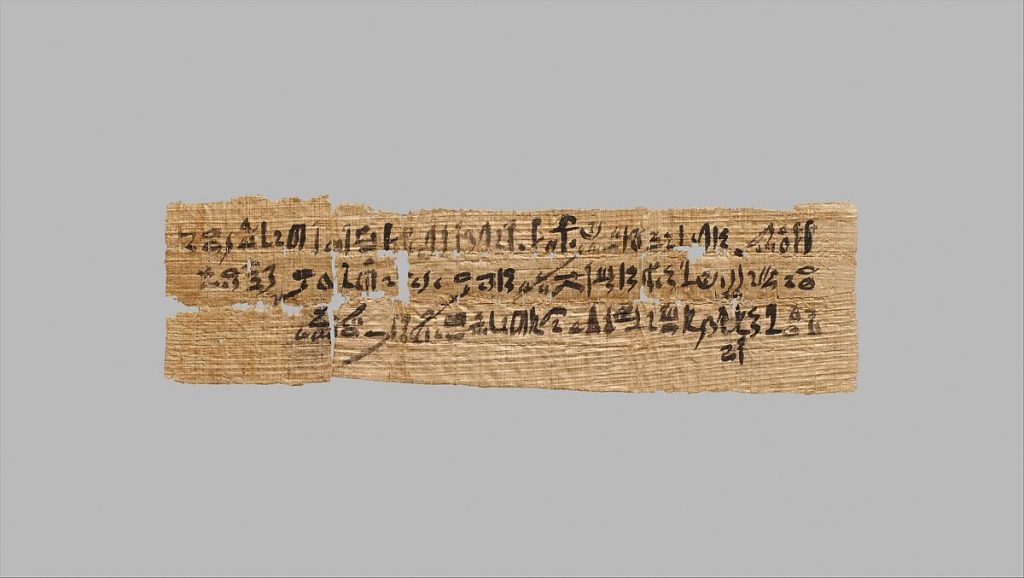
The typical scribal kit consisted of rush styluses (with reeds coming into use in the late first century B.C.), water, and cakes of ink, with a carbon-based black used for most texts and a red, fabricated with hematite, employed for emphasis (47.123a–g). Various additional colors could be used for illustrations. For most of Egyptian history, the script used on papyrus was hieratic, a cursive script (27.3.560); in later times, demotic, which developed from hieratic, then Greek and Coptic (25.8; 14.1.531), were also used. Scribes, or others among the 0.5 to 3 percent of the population who were literate (23.10.1), would write first on the inner surface of the roll, now known as the recto, where the fibers were horizontal, then move to the verso, the outer surface. Papyri were often erased and reused, and old strips could be layered with plaster as cartonnage, used for items like mummy masks (19.2.6).
Papyrus-making is a complex and time-consuming process that requires expertise in all aspects, from the cultivation and harvesting of plants to the manufacture of rolls. Many scholars believe that this was a state-run enterprise, at least in the later periods of Egyptian history; it has been suggested that the Greek term papuros comes from the Egyptian pa-per-aa, “that of the pharaoh,” although there is no substantial evidence for this. In any event, most likely due to the desire to move away from dependence on supplies from Egypt, parchment gradually superseded papyrus as the most popular material for writing. The latest known papyri date from around 1100 A.D., although even these are isolated examples.
The Book of the Dead
The expectation of life after death colored all aspects of life in ancient Egypt. Among the objects found in the coffins of the dead were papyrus scrolls containing prayers and incantations, or spells, to guide the soul into the afterlife. The Book of the Dead, which the Egyptians referred to as The Book of Coming Forth By Day, spells out the procedures through which the deceased had to pass before being admitted to the Field of Reeds, the eternal realm of the god Osiris. There, the deceased soul’s heart was weighed against how well he or she had treated others and respected the gods. A favorable judgment meant the soul would join other living souls in a realm of peace and joy. An unfavorable judgment meant the soul’s heart would be devoured by the monster Ament. The Book of the Dead contained incantations that might protect against an unfavorable judgment.
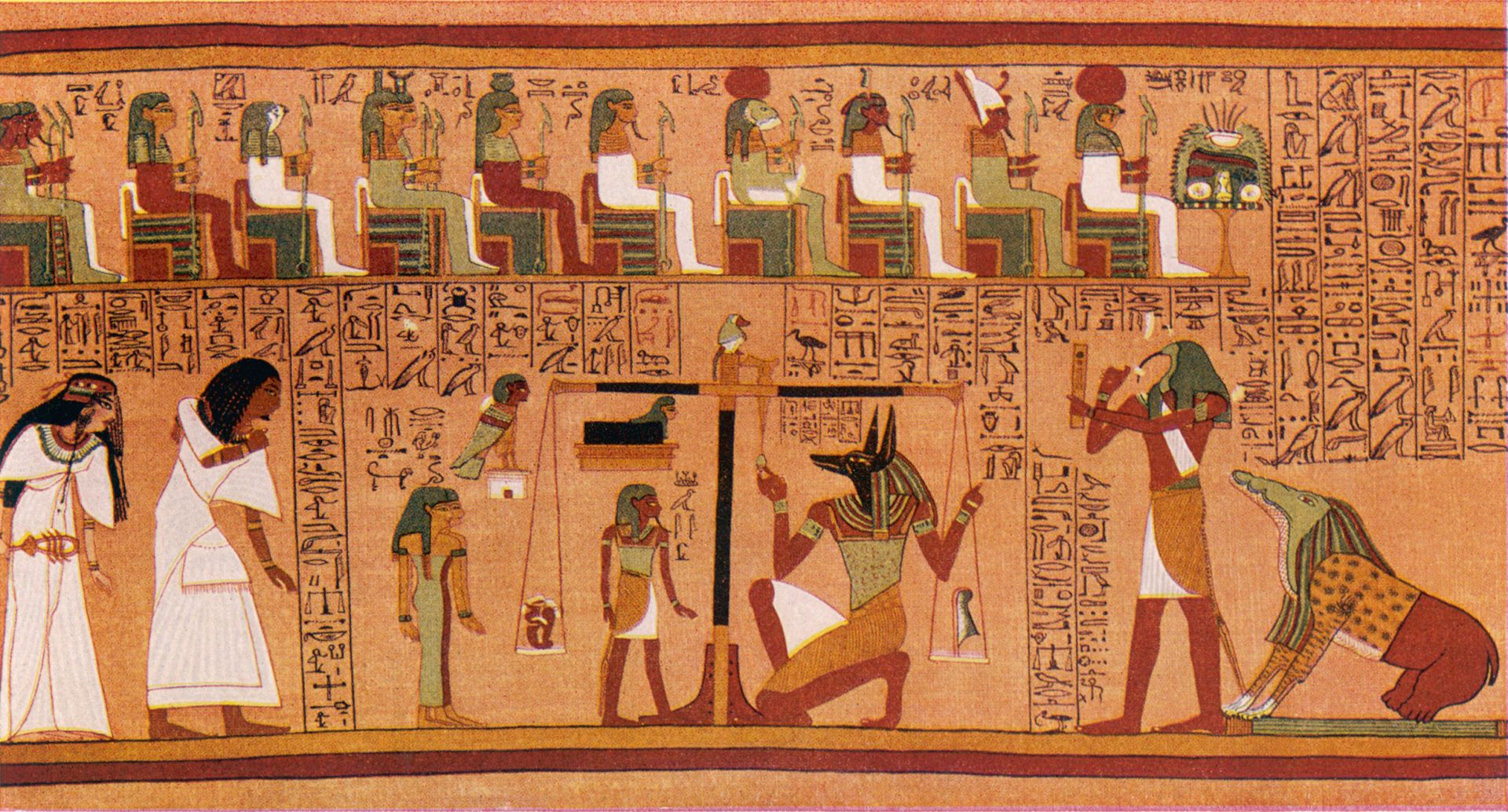
Unfortunately, other literature from ancient Egypt is not readily available. Most of what remains exist only in scattered fragments. The oldest Egyptian poems, dating from 2650-2050 BCE, are religious. Most are incantations and invocations to the gods to aid the departed Egyptian kings. But on the most important Egyptian religious poems is the pharaoh Akhenaten’s “Hymn to the Sun.” In this poem, Akhenaten presents himself as the son of Aten, and then describes the sun’s rising: “At dawn you rise shining in the horizon, you shine as Aten in the sky and drive away darkness by sending forth your rays. The Two Lands awake in festivity, and people stand on their feet, for you have raised them up. They wash their bodies, they take their garments, and their arms are raised to praise your rising. The whole world does its work.”
Other ancient Egyptian poems of interest include a series of lyrics composed between 2000-1000 BCE, especially the love poems written during the late Rameside period (1300-1100 BCE). As with later Greek and Roman love poetry, and the nearly equally ancient poetry of the Hebrews (the biblical Song of Songs), ancient Egyptian love poems display a wide range of mood and feeling. Written on limestone as well as on papyrus, these ancient love poems reflect attitudes that appear strikingly modern.
Questions
1. How has humans’ ability to create and tell stories helped our species survive and evolve?
2. What caused humans to build permanent settlements, rather than continuing in nomadic hunter-gatherer tribes? How did this change affect Neolithic cultures?
3. Written language has likely had a larger impact on humanity than any other invention. How did the creation of written language vastly change civilization
4. How would you define a story?
